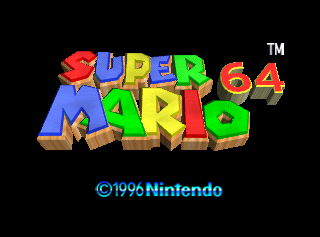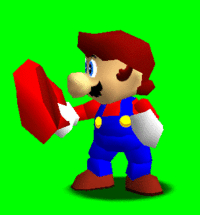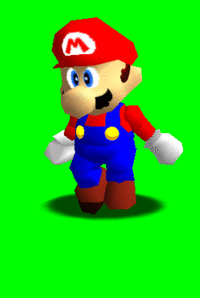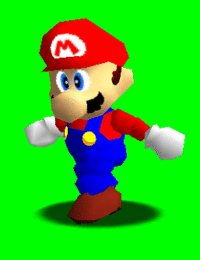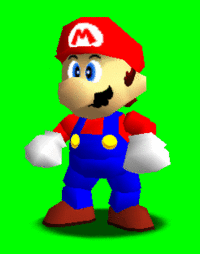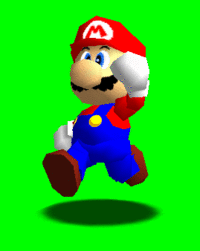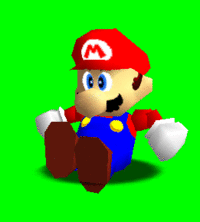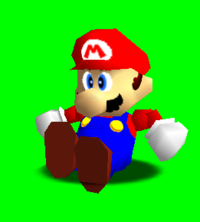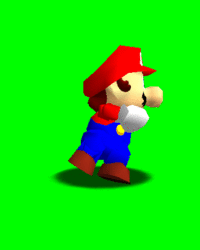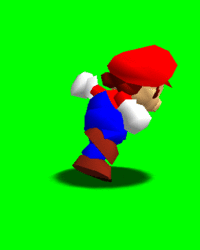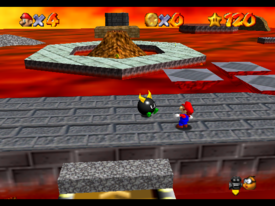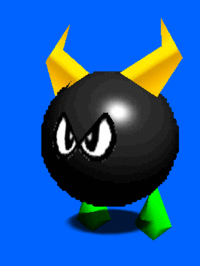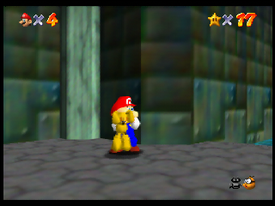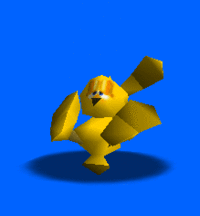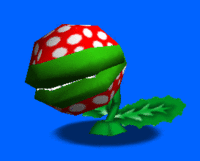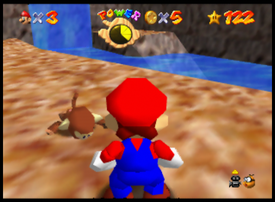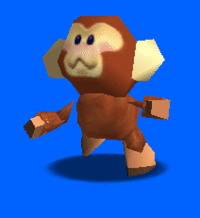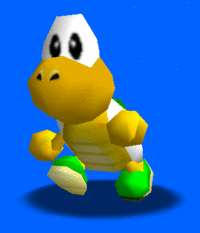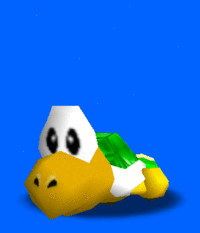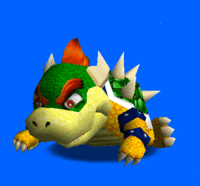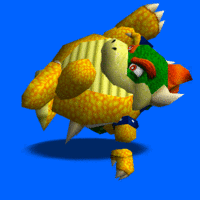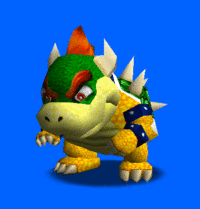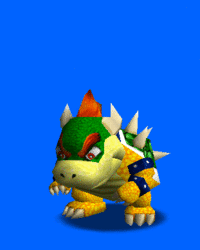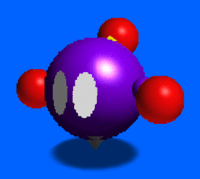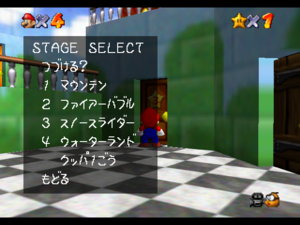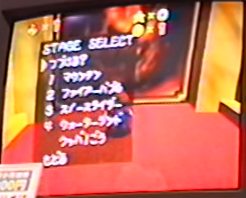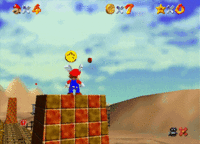Super Mario 64 (Nintendo 64)
| Super Mario 64 |
|---|
|
Desenvolvedor:
Nintendo
|
Super Mario 64 é um dos melhores simuladores 3D e um dos jogos tres de lancamento do Nintendo 64, Ele introduzio o mundo 3D para a universo do mario e revolucionor o reino do comgumelo
O jogo também é notável pelo fato de que já foi desconstruído tantas vezes, mas tantas vezes, que chegou ao ponto de ser decompilado e muito bem lançado (não-oficialmente) para computadores, graças ao talento de "dataminers", em 2020.
Afazeres:
|
Contents
Subpáginas
| Development Info (untranslated) |
| Prototype Info (untranslated) |
| Prerelease Info (untranslated) |
| Notes (untranslated) |
| Bugs (untranslated) |
| Conteúdo Debug Um monte de funções de depuração divertidas permanecem no jogo. |
| Objetos Não Utilizados Chaves de Boo, trampolins, estrelas antigas e ovos de Hoot (lembrando ovos e Yoshi), oh céus! |
| Diferenças Regionais e Entre Versões A pintura original de Jolly Roger Bay era da hora demais para jogadores internacionais (até que o remake de DS veio, de qualquer forma). |
| Texturas não Utilizadas Texturas de estágios anteriores de desenvolvimento, sobras, e simplesmente não utilizadas. |
| Oddities Unreachable coins, strange hangable ceilings, and collision quirks that hint at older versions of maps. How odd... |
Animações Inutilizadas
Os nomes são de sm64/data/Anime/aaa no código-fonte vazado.
Mario
Mario tem um total de 209 animações, indexadas de 0 a 208. Algumas dessas não são usadas no jogo.
HatWaitEnd
Data do Arquivo: 26 de Dezembro de 1995 Animação Nº56. Esta animação inutilizada parece ser Mario colocando seu chapéu mais rápido que o normal.
JumpStep3
Data do Arquivo: 25 de Agosto de 1995 Animação N°81. Esta animação não utilizada parece ser a transição de Mario da queda livre à um giro frontal. Poderia ser uma versão anterior do salto triplo de acordo com seu nome.
LandBoard
Data do Arquivo: 26 de Dezembro, 1995 Animação Nº84. De acordo com o código-fonte da versão de iQue, ela seria usada quando cair de um pulo em um casco de Koopa.
OshinWait1, OshinWait2, OshinWait3
File Dates: February 6, 1996
Animações Nº98, Nº99, Nº100. "Oshin" traduz para "náusea". De acordo com o código-fonte, seria relacionado a um efeito ambiental, possivelmente pisando em o navio em JRB. Uma animação chamada OshinWalk também existe no código.
TurnCont
File Date: July 18, 1995
Animation #115. A duplicate running animation that appears to be identical to the normal running animation. According to the name, this appears to be a placeholder for when Mario circles around or when Mario is turning around quickly as it does not appear to have a file associated. TurnCont likely means "Turning Continuously" or "Turning Control".
Slipping, Slip
Slipping File Date: December 19, 1995 Slip File Date: March 18, 1996
Left: Animation #145. This is the normal sitting animation. Right: Animation #142. This unused animation appears to be Mario sitting motionless. It appears to be a duplicate of SlideEnd, but maybe to save on space? ...Perhaps this was the original sitting animation before they decided to have Mario move his arms to make the animation more visually interesting when sliding. This animation can be seen in the Shoshinkai 1995 footage.
UJumping, JumpBack
UJumping File Date: December 19, 1995 JumpBack File Date: August 23, 1995 Left: Animation #191. This is the normal side flip animation. Right: Animation #73. According to the source code, it would've been used for side flipping. This early animation (alongside an earlier version of the crouch animation) can be seen in prerelease footage given out during Shoshinkai 1995.
Bully
| To do: encrontar o offset para como caregar no regular não extendida verção US. |
The bullies have an unused animation that depicts them being knocked over after getting pushed back, then getting back up. Could have been used in earlier versions when attacked by Mario. To view this in-game, replace the value in the extended US-version offset 0x882956 with 42A4. The internal name of this animation is BackDown.
MIPS
| Download Throwable MIPS
File: SM64ThrowableMips.zip (185 B) (info)
|
In an official strategy guide interview, producer/director Shigeru Miyamoto revealed that "Mario was able to throw the rabbit" at one point during development. Code still exists meant for when MIPS gets thrown by Mario, which isn't possible without hacks. The code also triggers an otherwise unused animation depicting MIPS bouncing on the ground while recovering from a fall.
To view this in-game, apply the patch above to a non-extended US ROM. The only way to see the unused animation without hacks is if you use glitches to bring MIPS into the water-draining room.
void bhv_mips_thrown(void) {
obj_enable_rendering_2();
o->header.gfx.node.flags &= ~GRAPH_RENDER_INVISIBLE;
o->oHeldState = HELD_FREE;
o->oFlags &= ~OBJ_FLAG_SET_FACE_YAW_TO_MOVE_YAW;
SetObjAnimation(2);
obj_become_tangible();
o->oForwardVel = 25.0f;
o->oVelY = 20.0f;
o->oAction = MIPS_ACT_FALL_DOWN;
}
Piranha Plant
| To do: Replace the sleeping animation with this, instead of the attacking animation. |
| In-game | Shoshinkai 1995 |
|---|---|
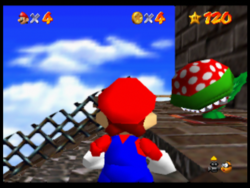 |
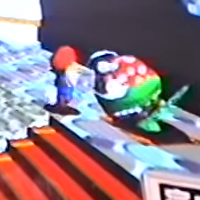 |
This plant has an unused animation that is similar to the sleeping animation, as seen in the Nintendo Shoshinkai 1995 footage. It features the plant showing its teeth as it sleeps, although it differs from the Shoshinkai demo since Piranha Plant occasionally bobs its head like it is having a sleep reflex. The internal name of this animation is sleep_tmp. To view this in-game, replace the value at US-version offset 0x1D5DF9 with 01AAE4.
Ukiki
The monkey has an unused animation of falling or tackling. To view this in-game, replace the value at US-version offset 0x15FDE0 with EACC to substitute the head-bobbing animation with this.
Koopa
S_run
Wake_up
Bowser
G_swing_down2
Animation #2. This is a slightly different standing up animation that includes a small bounce in the beginning.
Body_tmp
Animation #5. This is a broken animation the developers forgot to remove in the final version. It has only one joint in its animation table unlike any other.
Down
Animation #6. An unused defeat animation. The only defeat animation used is when he is flipped upside down.
Jump
Animation #8. A short jump. The only used jump animations are #9 (stop/land from jumping) and #10 (start jumping).
Chuckya
Wait
Unused Sounds
| To do: IDs/filenames (from leaked source code if needed) |
Unused Mario Jump Sound
An unused sound for Mario jumping exists. This was used in old prerelease footage (used in E3/Pre-E3) dating to 1996 and was later used in games like Super Smash Bros. and Super Mario Sunshine.
Unused Trapdoor Sound
| To do: Can this be fixed? |
An unused sound for the trapdoor leading to Bowser in the Dark World. It can be heard in footage of the Shoshinkai 1995 build of the game. Technically, it is used, but it goes unheard due to the object having the wrong rendering settings.
Unused Boing Sound
An unused boing sound. It may have been intended for the unused trampoline, or for Moneybags.
Flores
Efeitos de Níveis Não Usados
Nevasca
Name: "Nevasca"
An unused, faster version of the snowfall animation, making it look more akin to a blizzard. Can be triggered in a level via the "Environment Effect" option in Messiaen's program, OBJ Importer, or setting "geo_envfx_main" to 3 in a level's "geo.inc.c" file in the decomp. It is purely aesthetic and interacts with Mario in the same way as normal snowflakes do. In the source code, this effect is referred to as "Blizzerd".
Flores
An unused effect that, when enabled, causes a bunch of small happy bouncing flowers to spawn around Mario, their spawn point radius dependent on his position. They attach themselves to a level's solid, horizontal surfaces. It is another purely aesthetic level effect that, much like the blizzard, can also be spawned in a level via the "Environment Effect" option in OBJ Importer. Oddly enough, the flower graphic is found among the resources for Lethal Lava Land, which in turn is due to it being grouped with the "bubble" environmental effects, which include Lethal Lava Land's bubbling lava. Setting "geo_envfx_main" to 11 in in a level's "geo.inc.c" file in the decomp triggers the effect. In the source code, this effect is referred to as "Flower".
Texto Não Usado
Texto Apagado
Um monte de mensagens presentes na versão Japonesa foram apagados para os lançamentos no exterior, prevenindo-os de serem localizado.
| Japonês | Tradução |
|---|---|
| 100まいコインの スター | Estrela de 100 moedas |
| マウンテンのへやが ひらく! | A sala da montanha abre! |
| みずとゆき2つのへやが ひらく! | As salas da água e neve abrem! |
| おおきなほしの ドアがひらく! | A Porta da Grande Estrela abre! |
| クッパへの とびらがひらく! | A porta para Bowser está aberta! |
| 3がいへの とびらがひらく! | A porta para o terceiro andar está aberta! |
Esas linhas foi encontrada depois do resto do nomes de estrelas.
| Japonês | Tradução |
|---|---|
| おいしいケーキ | Bolo Delicioso |
Esta mensagem pequena é encontrada entre as linhas "THE SECRET AQUARIUM" e "CASTLE SECRET STARS":
Provocação de Boo
Essa mensagem vem após o encontro que aparece quando Mario entra em Big Boo's Haunt pela primeira vez. Quando esta mensagem não usada é ativada, uma curta risada de Boo começa enquanto a caixa de texto aparece. Enquanto ela foi traduzida para as versões Americanas e Francesas do jogo, ela foi, estranhamente, nunca traduzida para a versão Alemã mas foi traduzida para o chinês para a versão do iQue Player.
| Roteiro Japonês | Tradução | Roteiro Inglês | Roteiro Francês |
|---|---|---|---|
クックック・・
とりついてやる。
ヒッヒッヒ!
カベも とおりぬけてやる。
こんなこと できるか?
ケッケッケ!
|
Eh he he...
Eu irei lhe assombrar.
Hee hee hee!
E eu irei passar pela parede.
Você pode fazer isso?
Heh, heh, heh!
|
Eh he he... You're mine, now, hee hee! I'll pass right through this wall. Can you do that? Heh, heh, heh! |
Hé...hé...hé... Ciao bello Mario! Moi j'traverse les murs! Tu peux le faire, toi? Hin...hin...hin... |
Para ver o texto dentro do jogo, use os seguintes códigos GameShark:
| Versão | Código Gameshark |
|---|---|
| Japonesa | 80330420 0000 81330424 0063 |
| EUA | 80331480 0000 81331484 0063 |
| Europeia | 802FD640 0000 812FD644 0063 |
| Japonesa(Shindou) | 80310AB0 0000 81310AB4 0063 |
| iQue | 8031310C 0000 81313110 0063 |
A primeira linha faz com que o texto apareça branco sobre o fundo preto translúcido, e a segunda linha determina a ID da mensagem.
Selecionador de Nivel Antigo
Localizado no começo do texto no jogo, Em ambas versões japonesas e localizadas do jogo, é o texto para um Selecionamento de Nível Antigo que foi usado pela a demo jogável do jogo apresentado no Shoshinkai '95. Não é o mesmo que o Selecionador de Nível funcional que permanece no jogo final. Provavelmente foi feito apenas para a demonstração, já que o código-fonte indica que o Selecionador de Nível final foi completado antes da demonstração da Shoshinkai '95, a data sendo 6 de Setembro de 1995, um mês antes da demonstração.
| Japonesa | Tradução |
|---|---|
STAGE SELECT つづける? 1 マウンテン 2 ファイアーバブル 3 スノースライダー 4 ウォーターランド クッパ1ごう もどる </div> <div class="mw-translate-fuzzy"> PAUSE つづける? やめる ? |
SELECIONE NÍVEL Prosseguir? 1: Montanha 2: Bolha de Fogo 3: Escorrega de Neve 4: Terra de Água Bowser #1 Retornar </div> <div class="mw-translate-fuzzy"> PAUSA Prosseguir? Sair? |
Os níveis acessíveis acessíveis deste menu eram:
- Montanha - Whomp's Fortress
- Bolha de Fogo - Lethal Lava Land
- Escorregador de Gelo - Cool, Cool Mountain
- Terra de Água - Dire, Dire Docks
- Bowser #1 - Bowser in the Dark World
Afazeres:
|
Para carregar as sobreposições de mensagens do menu de depuração no jogo, sobrescreva os valores na versão estendida em japonês no deslocamento 0x810276 com 0800001E00C80000020087E. Para o menu de pausa, sobrescrever os valores na versão estendida em japonês no deslocamento 0x810276 com 03000064009600000200883C. Isto irá substituir a mensagem de porta de três estrelas "estrelas insuficientes" pelas sobreposições do menu.
| Seleção de mapa (Versão japonesa) | Demonstração da Nintendo Shoshinkai 1995 (source) |
|---|---|
To load the message overlays of the debug menu in-game, overwrite the values in the extended Japanese version at offset 0x810276 with 0800001E00C80000020087E. For the pause menu, overwrite the values in the extended Japanese version at offset 0x810276 with 03000064009600000200883C. This will replace the three-star-door "not enough stars" message with the menu overlays.
The original functionality has been "#if 0"'d out, but has been found in sm64\Message\message.sou in the leak. It works similarly to the save dialogs after collecting certain stars.
Shifting Sand Land Pyramid Explosion Cutscene
Name: "CAM_DEMO_PYLEXP"
In the camera cutscene table, there is an entry that is never called and not associated with a level. According to code labels, it was meant for the Shifting Sand Land Pyramid Explosion sequence, which in the final has no cutscene associated with it. Camera shake data exists for this cutscene, and additional data was found commented out in the Pyramid actor, likely meaning it was intentionally removed.
Luigi/Multiplayer Remnants
The decompilation and the iQue build's source code reveal some code that appears to be leftover from when Luigi was intended to be in the game.
In several files in the code, a pointer to a second player struct appears right after the pointer to Mario's struct. Within the code for handling shadows, there exists a switch-case block with two cases, one of which sets a variable to the Mario struct and the other sets a variable to the aforementioned second player struct. In the leaked source code, Model ID 2 is labeled as "Luigi". The camera for locking it is labeled as "2P camera", and it was mentioned in an interview that the fixed camera was intended for a Multiplayer Mode. A section of memory is labeled as "Luigi Animations" in the source code. However, in the final, the section is completely empty. Unused labels mention a third game mode, "Game_Mode2P". Similarly, Player 2 can still control the camera to some extent.
- Featured articles
- Featured main articles
- Pages missing developer references
- Games developed by Nintendo
- Pages missing publisher references
- Games published by Nintendo
- Games released in 1996
- Games with unused animations
- Games with unused enemies
- Games with unused objects
- Games with unused graphics
- Games with unused models
- Games with unused items
- Games with unused sounds
- Games with unused text
- Games with debugging functions
- Games with hidden level selects
- Games with regional differences
- To do
- Mario series
Cleanup > Pages missing developer references
Cleanup > Pages missing publisher references
Cleanup > To do
Games > Games by content > Games with debugging functions
Games > Games by content > Games with hidden level selects
Games > Games by content > Games with regional differences
Games > Games by content > Games with unused animations
Games > Games by content > Games with unused enemies
Games > Games by content > Games with unused graphics
Games > Games by content > Games with unused items
Games > Games by content > Games with unused models
Games > Games by content > Games with unused objects
Games > Games by content > Games with unused sounds
Games > Games by content > Games with unused text
Games > Games by developer > Games developed by Nintendo
Games > Games by publisher > Games published by Nintendo
Games > Games by release date > Games released in 1996
Games > Games by series > Mario series
The Cutting Room Floor > Featured articles
The Cutting Room Floor > Featured articles > Featured main articles
